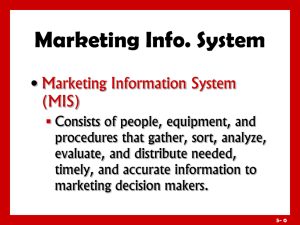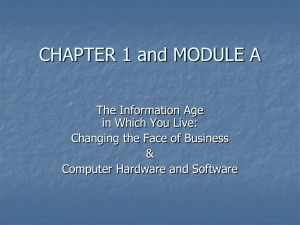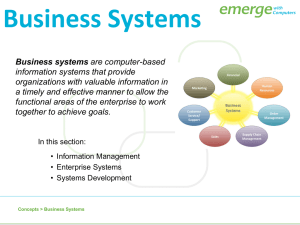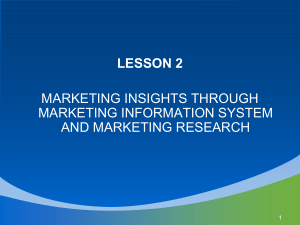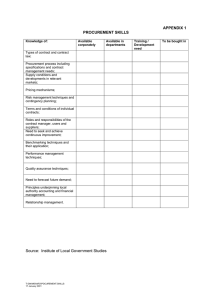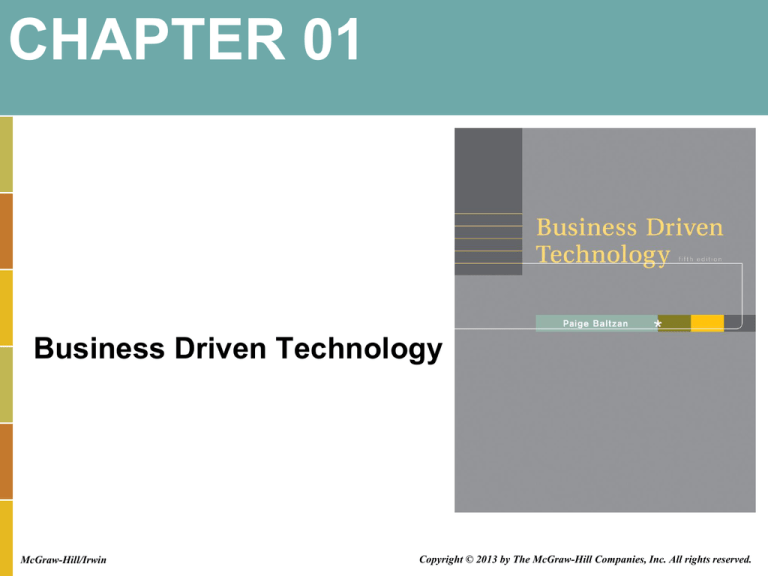
CHAPTER 01
Business Driven Technology
McGraw-Hill/Irwin
Copyright © 2013 by The McGraw-Hill Companies, Inc. All rights reserved.
LEARNING OUTCOMES
1. Describe the information age and the
differences between data, information,
business intelligence, and knowledge.
2. Identify the different departments in a
company and why they must work
together to achieve success.
3. Explain systems thinking and how
management information systems
enable business communications.
1-2
COMPETING IN THE
INFORMATION AGE
• Currently infinite quantities of facts are widely
available to anyone who can use a computer
• Many business leaders have created
exceptional opportunities by coupling the power
of the information age with
traditional business
methods
1-3
COMPETING IN THE
INFORMATION AGE
• Examples of the power of business and
technology:
– Amazon—Not a technology company; primary
business focus is selling books
– Netflix—Not a technology company;
primary business focus is renting videos
– Zappos—Not a technology company;
primary business focus is selling shoes
1-4
INFORMATION TECHNOLOGY’S ROLE
IN BUSINESS
• Information technology is everywhere in
business
• Understanding information technology
provides greater
insight to anyone
learning about
business
1-5
INFORMATION TECHNOLOGY’S IMPACT ON
BUSINESS OPERATIONS
• Organizations typically
operate by functional
areas or functional silos
• Functional areas are
interdependent
• IT plays a critical role in
deploying
enterprisewide initiatives
to achieve business
goals
1-6
INFORMATION TECHNOLOGY BASICS
• Information technology (IT)—A field
concerned with the use of technology in
managing and processing information
• Information technology is an important enabler
of business success and innovation
1-7
INFORMATION TECHNOLOGY BASICS
• Management information systems (MIS)—A
general name for the business function and
academic discipline covering the application of
people, technologies, and procedures –
collectively called information systems – to
solve business problems
• MIS is a business function, similar to
Accounting, Finance, Operations, and Human
Resources
1-8
INFORMATION TECHNOLOGY BASICS
• When beginning to learn about information
technology it is important to understand the
following:
–
–
–
–
Data, information, and business intelligence
IT resources
The challenge: departmental companies
The solution: management information system
1-9
DATA, INFORMATATION, AND
BUSINESS INTELLIGENCE
• Data—raw facts that describe the
characteristic of an event
• Information—data converted into a
meaningful and useful context
• Business Intelligence—applications and
technologies that are used to gather, provide
access to, and analyze data and information
to support decision-making efforts
1-10
IT RESOURCES
• The plans and goals of the IT department
must align with the plans and goals of the
organization
• People use
• Information technology
to work with
• Information
1-11
THE CHALLENGE:
DEPARTMENTAL COMPANIES
Common Departments Working Independently
1-12
THE SOLUTION: MANAGEMENT
INFORMATION SYSTEMS
Common Departments Working
Interdependently
1-13
THE SOLUTION: MANAGEMENT
INFORMATION SYSTEMS
Systems thinking—A way of monitoring the entire
system by viewing multiple inputs being processed or
transformed to produce outputs while continuously
gathering feedback
1-14
THE SOLUTION: MANAGEMENT
INFORMATION SYSTEMS
Management Information Systems (MIS)—
A business function, like accounting and human
resources, which moves information about
people, products, and processes across the
company to facilitate decision-making and
problem-solving
1-15


